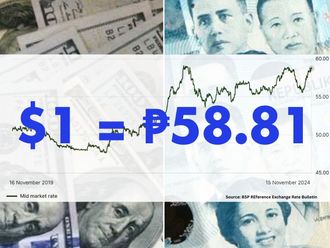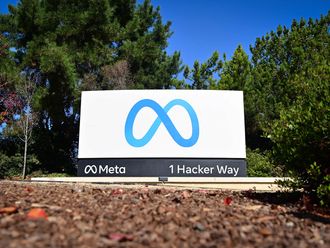Dubai: Lifting 142 million people - crammed within 147,000 square kilometres of low-lying alluvial plains that translates to a population density of 965 per square kilometres - out of poverty is not easy. For Bangladesh’s Prime Minister Sheikh Hasina, this is an uphill task.
With a gross domestic product (GDP) expected to cross $120 billion this year, Bangladesh is ranked 56th biggest economy in the world – close to the size of the economies of Iraq and Vietnam. The per capita GDP – at $775 – is still one of the lowest in the world.
With an imbalance in trade in which import bill of $24 billion is roughly 50 per cent more than its exports earnings of $17 billion, the country manages its balance of trade, especially the foreign currency requirements from the $12 billion remittances made by more than 8 million non-resident Bangladeshis in six continents. More than half is sent by Bangladeshi expatriates living in the Gulf, including $2 billion from the UAE.
It has a private sector of 30 million businessmen, of which only three million have tax identification number (TIN). The rest simply do not pay taxes. This reflects the level of patriotism of the rich in a poor country.
Hasina’s government came to power in January 2009 armed with Vision 2021 - to eliminate poverty, corruption, to digitise government services and to transform Bangladesh in to a middle-income country when the nation celebrates its 50th birthday in 2021.
“Managing economic development amid growing social, economic and political challenges is a huge task. But we are on it and there are certain achievements that the country could be proud of,” Hossain Taufique Imam, Advisor to Bangladeshi Prime Minister, tells Gulf News.
Despite the global economic downturn, the country has set a 7.2 per cent GDP growth target for 2012-13 financial starting next month after it is set to record 6.7 per cent growth in the last financial year ending June 30, 2011. The current year, which closes later this month, is expected to record 6.3 per cent GDP growth.
“It could be tough to achieve, but not impossible. Bangladesh is a growing economy and despite the infrastructure bottlenecks, the economy will continue to grow at a much higher than the world average,” he says.
Bangladesh Finance Minister AMA Muhith last week tabled a Tk1.92 trillion ($24 billion) budget, which is about 20 per cent of the country’s GDP.
Imam, a senior bureaucrat – who was the first Cabinet Secretary of Bangladesh from 1971 till 1975 - has overseen the initial challenges faced by the new-born country that was bleeding from a nine-month bloody war of independence in 1971.
Like most newly independent countries, Bangladesh – then with a population of 75 million – had to overcome the post-colonial trauma in addition to the rehabilitation of 10 million refugees, establish an administration, print money, develop police force, army and establish law and order – from scrach.
“In 1971-72, we used to suffer from food shortage. However, 40 years later and with doubling of the population, we have now become self-sufficient in basic foodgrain production,” he says. “This itself is a major achievement.”
Imam, who has worked closely with Bangladesh’s founding father Bangabandhu Sheikh Mujibur Rahman till after his assassination in 1975, was asked by Sheikh Mujib’s daughter Sheikh Hasina to help run the administration following Hasina’s victory in elections held in December 2008. He was later named an advisor when Hasina formed a government in January 2009 for the second time.
As the clock ticks near 2015 – the year the country is expected to halve its poverty as part of the Millennium Development Goals (MDGs) – Bangladesh appears to be on track to achieve part of the MDGs, despite mounting challenges.
“Our development activities have been challenged due to the shortage in energy and power output – something that we are trying to overcome,” Imam said.
Bangladesh added 2,500 megawatts of power in three years. Its current power output of 5,500 megawatts is way below requirement.
“There are 90 million mobile handsets that needs to be charged every day. We have battery-powered three-wheelers that are mushrooming in rural areas that need to be charged every night that require 300 megawatt power every day and it is increasing,” he says. “On top of this, we have given power connections to 2.1 million new households, commercial establishments and industries that is causing frequent power outage.”
During the cultivation, the country diverts electricity supply to rural areas for irrigation – which causes inconvenience to urban life. The government’s immediate challenge, however, remains a reduction in power subsidies that is eating up a large chunk of revenue.
David Cowen, head of the IMF mission to Bangladesh, said last month, “Fuel, electricity, and fertiliser subsidies continue to require close watch, given the pressures they have exerted on the budget over the past year.”
However, the good news is - the country’s three and a half-year-old government has created 8.5 million jobs, including 1.7 million overseas – mostly unskilled workers.
It has reduced poverty by a half from 48.9 per cent in 2000 to 31.5 per cent in 2010 - well before the MGD target of 2015, while life expectancy at 69 years is well above the average of South Asian and low-income countries, according to World Bank data.
Bangladesh’s Gini coefficient stood at 0.33, slightly lower than India’s 0.36 and Nepal’s 0.47 in 2009. The Gini coefficient measures inequality and always ranges from zero to one. Zero means perfect equality and one signifies perfect inequality.
This could be credited to the high female literacy rate in Bangladesh, says Ravi Srivastava, a professor with the Social Sciences department of Jawaharlal Nehru University.
In Bangladesh, youth female literacy is higher than the male one. As many as 76.8 per cent of females are literate, against 74.1 per cent of males. In India, female youth literacy was at 74 per cent in 2009, lower than Bangladesh.
Bangladesh has been ruled by two women prime ministers – Khaleda Zia and Shaikh Hasina – since democracy was restored in 1991. Little has changed in terms of empowering women.
However things are looking up. The country now has more women professionals, entrepreneurs and leaders than those countries that have a Muslim majority. Its garments industry which represents 80 per cent of exports, employs more than three million women.
Bangladesh to eliminate illiteracy by 2015
Dubai: Bangladesh is likely to eliminate illiteracy by 2015 – ahead of its target of 2021, Hossain Taufique Imam, Advisor to Bangladeshi Prime Minister, says. The country’s literacy rate has improved to 67 per cent this year – up from 45 per cent about a decade ago.
“Our plan was to eliminate illiteracy by 2021, as part of our Vision 2021,” Imam, says. “However, we are likely to achieve that by 2015. We have seen 100 per cent primary enrolment and zero drop out incidents. We are also going to start introducing dining programme in schools.”
The government has changed the educational system from a 10+2 year to a three-tier system split among Primary School – KG to Grade 5, Medium School from Grade 5-8 and Secondary School – from 8 to 12. As a result, students now compete in countrywide competitive exams in Grade 5, 8 and 12 following which they then could take up vocational education or enter universities.
Primary education is free and girls are offered extra incentives to pursue higher studies – and become part of the country’s economic landscape. Women are 49 per cent of the country’s population and generally end up being housewives.
The government has doubled its annual allocation for education sector’s development and has allocated Tk393.90 billion ($4.8 billion) in education sector development in the 2012-2013 budget, up from Tk198.37 billion allocated in the current fiscal year ending June 30, 2012.
Education sector receives the highest allocation in the budget.
“Technology-related education is getting a top priority as government is giving a lot of emphasis on human resource development and empowerment of men and women,” he said.












